Kempley, Gloucestershire c.1120
Christ in Majesty
(with apocalypse details)
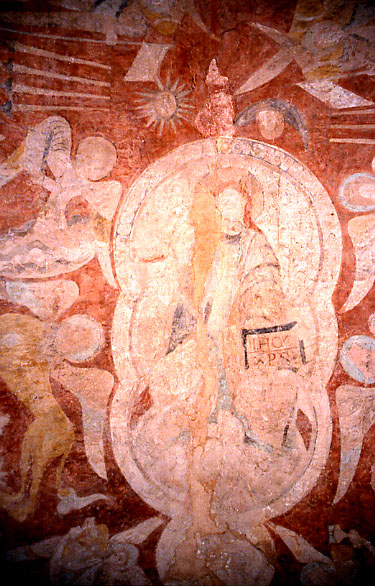
These very early and very important paintings are in the barrel-vaulted chancel, which is painted throughout, including the ceiling; at the centre of this is Christ in Majesty in a lobed mandorla.
Christ holds a book or tablet inscribed with the Greek monogram initials IXC and XPS. Above his head, outside the mandorla, are the sun and moon. He sits on a rainbow, and the orb of the earth below his feet is specifically his footstool, as in Matthew 5:35. Surrounding the mandorla are the four Evangelist symbols, angels, and the Seven Golden Candlesticks of Revelation 1:12, all shown in the detailed photographs below.

The paintings are often described as frescoes, but this is not really accurate. The plaster in the chancel would have been put on the walls soon after the church was built in the early 12th century, so it would have been new, if not newly-applied, and possibly still not fully dry when the pigments were added. Some details were certainly added later when the scheme was otherwise complete and the plaster fully dry. These may have included details in blue azurite pigment, discovered here in 1989 and visible in the haloes of the Evangelists’ symbolic figures. Those of John (the Eagle) and Luke (the Ox) are shown to the left. John’s Eagle, identifiable, despite its human-looking face, by the claws in which it holds a tablet or book, is at the right, with the Ox at the left.
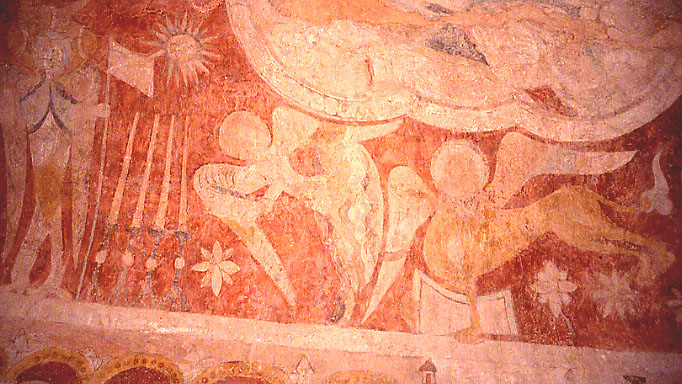
Beyond the Ox, one of two Cherubim holds a banner-like scroll, while at the far right are three of Revelation’s Golden Candlesticks as mentioned above.
On the other side of the mandorla, Mark’s Lion, at the right with a tablet clutched in its foreleg, and Matthew’s man or angel – always the least clear-cut of the four Evangelist symbols and here a blend of the two, approximating to a winged human shape above the waist and dissolving into diffuse waviness below – complete the Evangelist symbols (detail, above), then come the remaining four Candlesticks along with the rayed sun above them and a Seraph beyond, with a lance and pennant.

A second Seraph, with St Peter holding a very prominent key beside him, is on the other side of the mandorla (detail, left), the crescent moon shows again, and the roughly oval shape beside it is in fact its ‘human’ face, in allusion, I think, to the ancient belief that angelic presences in the various heavenly spheres guided them, causing them, among other things, to ‘sing’ in celestial harmony.

Peter is paired in the overall scheme with the Virgin, who stands on the opposite side of the mandorla, crowned, and with her hands raised in front of her (detail, right). She may be holding a small church in her hands, as the leaflet in the church claims, but Tristram does not mention this, and the detail is not clear in his drawing.¹
Above the Candlesticks, the Sun is given similar treatment to the moon described above, and the facial features show rather better here. Surrounding all are stars in a variety of designs; this is the firmament of Heaven at the moment of Apocalypse, or ‘Unveiling’, and we have come full circle around it on the ceiling. There are, though, many more details on the walls of the chancel, and these are dealt with below.
In early paintings of this subject, it is common to find the Apostles included as co-assessors at the Judgement, and that is the case at Kempley, where they are painted on the south and north walls of the chancel. The detail at the left below shows the south wall. Identifying individual Apostles is difficult, but the figure second from the left (detail, below left) holds a book, perhaps making him the Apostle who was also an Evangelist, i.e Matthew, writer of the first of the four Gospels. The figure at the far right of the group on the north wall is Peter again, identified by his key.
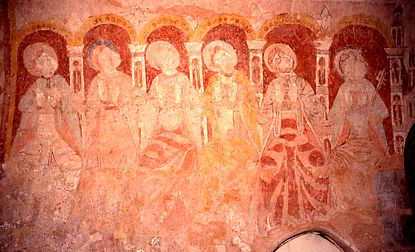
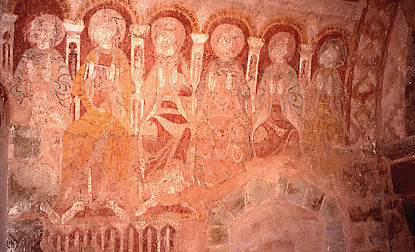
All twelve tilt their heads to gaze on Christ in Majesty on the ceiling, and the whorls and loops of their draped robes, typical of the period, show very well.
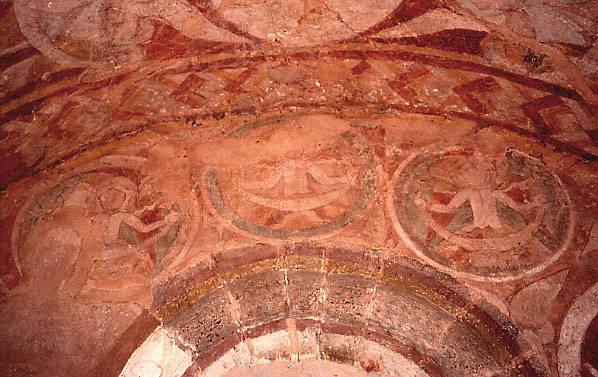
Above a window on the east, or altar, wall and thus below Christ’s feet, are three medallions showing angels with scrolls. In some respects these are similar to the contemporary roundels with Apostles at Houghton-on-the-Hill, also on the east wall, but these figures are undoubtedly angels, with visible wings, and they may represent orders of angels other than Cherubim and Seraphim – perhaps Thrones, whose task is to sustain God as well as adore Him – or angels at a hierarchical level below that.
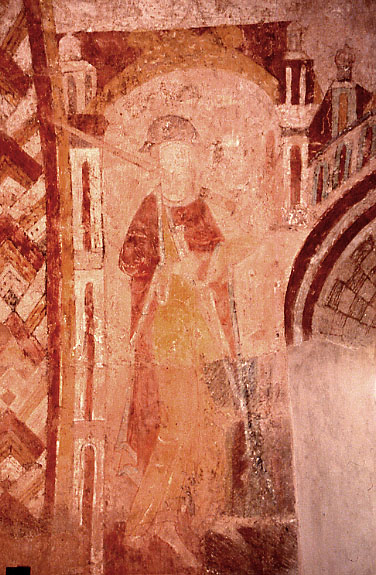
Below and on either side of the seated Apostles are two standing figures in painted arches. The one on the left (north) has disappeared completely, apart from a right hand raised in blessing, but on the right (south) is a very fine figure of a Bishop, (detail, right) vested for Mass and also blessing. This may be the then Bishop of Hereford, some 20 miles away (the Diocese of Gloucester dates only from the 16th century).
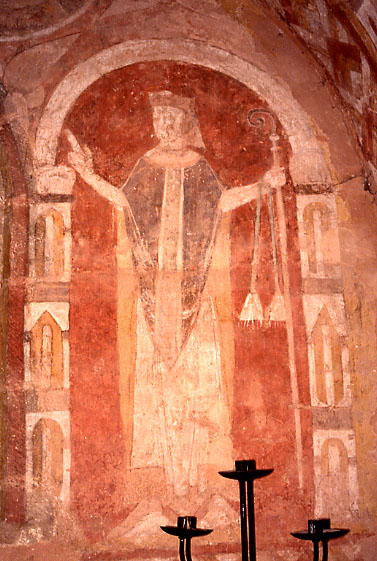
Two more figures complete the scheme. To the left is the clearer, dressed as a pilgrim with the addition of a sword over his shoulder. This might, as suggested by the booklet in the church, be Hugh de Lacy, who fought with his father Walter and brother Roger at the battle of Hastings in 1066 and almost certainly built the church at Kempley. Alternatively, he may be St James himself, a possibility strengthened, I think, by his honoured position at the easternmost point on the south wall, as close as possible to the High Altar and on the same horizontal level and scale as the six Apostles further west beyond the window-arch partly visible here.
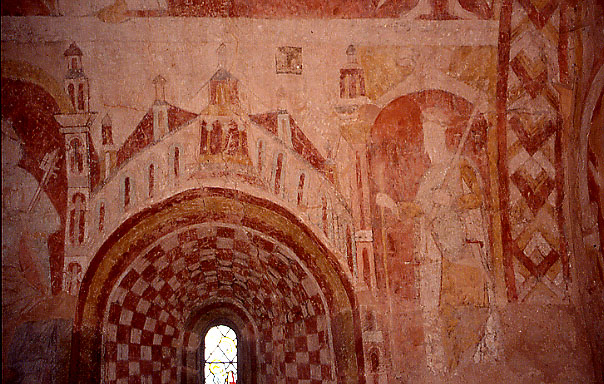
Across the chancel on the north, also beside a window, is his companion pilgrim (left, right of window), a much fainter figure who is possibly Hugh’s father Walter, who built the church of St Peter at Hereford and died in 1085 after falling from its tower, or alternatively another pilgrim saint. There are various possibilities, including the Egyptian Christian St Mennas, who was said to have been martyred under Diocletian. His shrine near Alexandria was much visited until Arab incursions in the 7th century made it inaccessible, and his feast is known to have been kept at Hereford.
The architecture of the Heavenly Jerusalem – ultimate goal of all pilgrims – and the chequered pattern around the window show well here. There is much more at Kempley, where the nave is also fully painted, but with the exception of the Three Marys at the sepulchre all the paintings there date from the 14th and 15th centuries. There are other wall paintings of comparable antiquity in Gloucestershire, but Kempley’s chancel scheme is really best compared with a group of very early paintings in Sussex, included in the list below.
Website for St Mary’s Church, Kempley
¹Tristram 1, p.135 & pl.60